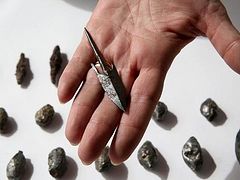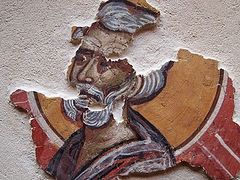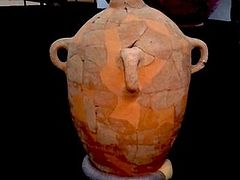Source: Bible History Daily
December 3, 2015
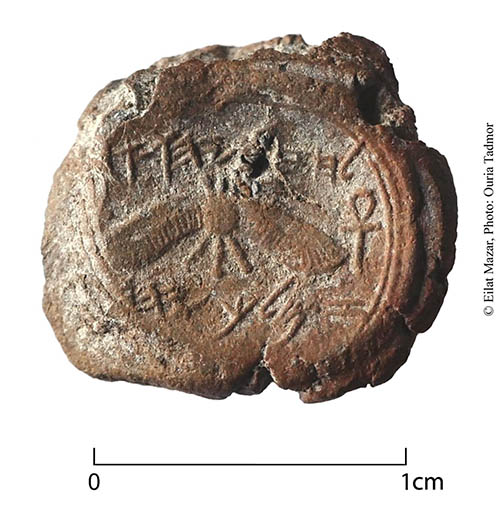 HEZEKIAH IN THE BIBLE. The royal seal of Hezekiah, king of Judah, was discovered in the Ophel excavations under the direction of archaeologist Eilat Mazar. Photo: Courtesy of Dr. Eilat Mazar; photo by Ouria Tadmor.
HEZEKIAH IN THE BIBLE. The royal seal of Hezekiah, king of Judah, was discovered in the Ophel excavations under the direction of archaeologist Eilat Mazar. Photo: Courtesy of Dr. Eilat Mazar; photo by Ouria Tadmor.
For the first time, the royal seal of King Hezekiah in the Bible has been found in an archaeological excavation. The stamped clay seal, also known as a bulla, was discovered in the Ophel excavations led by Dr. Eilat Mazar at the foot of the southern wall of the Temple Mount in Jerusalem. The discovery was announced in a recent press release by the Hebrew University of Jerusalem’s Institute of Archaeology, under whose auspices the excavations were conducted.
The bulla, which measures just over a centimeter in diameter, bears a seal impression depicting a two-winged sun disk flanked by ankh symbols and containing a Hebrew inscription that reads “Belonging to Hezekiah, (son of) Ahaz, king of Judah.” The bulla was discovered along with 33 other stamped bullae during wet-sifting of dirt from a refuse dump located next to a 10th-century B.C.E. royal building in the Ophel.
In the ancient Near East, clay bullae were used to secure the strings tied around rolled-up documents. The bullae were made by pressing a seal onto a wet lump of clay. The stamped bulla served as both a signature and as a means of ensuring the authenticity of the documents.
Hezekiah, son and successor of Ahaz and the 13th king of Judah (reigning c. 715–686 B.C.E.), was known for his religious reforms and attempts to gain independence from the Assyrians.
 The Ophel excavation area at the foot of the southern wall of the Temple Mount in Jerusalem. Photo: Andrew Shiva.
The Ophel excavation area at the foot of the southern wall of the Temple Mount in Jerusalem. Photo: Andrew Shiva.
In Aspects of Monotheism: How God Is One (Biblical Archaeology Society, 1997), Biblical scholar P. Kyle McCarter, Jr., summarizes Hezekiah’s religious reforms:
According to 2 Chronicles 29–32, Hezekiah began his reform in the first year of his reign; motivated by the belief that the ancient religion was not being practiced scrupulously, he ordered that the Temple of Yahweh be repaired and cleansed of niddâ (impurity). After celebrating a truly national Passover for the first time since the reign of Solomon (2 Chronicles 30:26), Hezekiah’s officials went into the countryside and dismantled the local shrines or “high places” (bamot) along with their altars, “standing stones” (masseboth) and “sacred poles” (’aásûeµrîm). The account of Hezekiah’s reform activities in 2 Kings 18:1–8 is much briefer. Although he is credited with removing the high places, the major reform is credited to Josiah (2 Kings 22:3–23:25).
Hezekiah’s attempts to save Jerusalem from Assyrian king Sennacherib’s invasion in 701 B.C.E. are chronicled in both the Bible and in Assyrian accounts. According to the Bible, Hezekiah, anticipating the attack, fortified and expanded the city’s walls and built a tunnel, known today as Hezekiah’s Tunnel, to ensure that the besieged city could still receive water (2 Chronicles 32:2–4; 2 Kings 20:20).
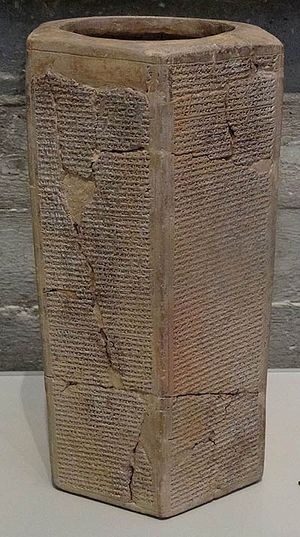 The Sennacherib Prism on display in the Israel Museum in Jerusalem. Photo: Hanay’s image is licensed under CC BY-SA 3.0/ Wikimedia Commons.
The Sennacherib Prism on display in the Israel Museum in Jerusalem. Photo: Hanay’s image is licensed under CC BY-SA 3.0/ Wikimedia Commons.
The bulla discovered in the Ophel excavations represents the first time the royal seal of Hezekiah has been found on an archaeological project.
“Although seal impressions bearing King Hezekiah’s name have already been known from the antiquities market since the middle of the 1990s—some with a winged scarab (dung beetle) symbol and others with a winged sun—this is the first time that a seal impression of an Israelite or Judean king has ever come to light in a scientific archaeological excavation,” Eilat Mazar said in the Hebrew University press release.
Bullae bearing the seal impressions of Hezekiah have been published in Biblical Archaeology Review. In the March/April 1999 issue, epigrapher Frank Moore Cross wrote about a bulla depicting a two-winged scarab. The bulla belonged to the private collection of antiquities collector Shlomo Moussaieff.[1] In the July/August 2002 issue, epigrapher Robert Deutsch discussed a bulla stamped with the image of a two-winged sun disk flanked by ankh symbols—similar to the one uncovered in the Ophel excavations. Both bullae published by Cross and Deutsch bear a Hebrew inscription reading “Belonging to Hezekiah, (son of) Ahaz, king of Judah.”
The Hebrew University press release explains the iconography on the Ophel bulla and other seal impressions of Hezekiah:
The symbols on the seal impression from the Ophel suggest that they were made late in his life, when both the royal administrative authority and the king’s personal symbols changed from the winged scarab (dung beetle)—the symbol of power and rule that had been familiar throughout the ancient Near East, to that of the winged sun—a motif that proclaimed God’s protection, which gave the regime its legitimacy and power, also widespread throughout the ancient Near East and used by the Assyrian kings.
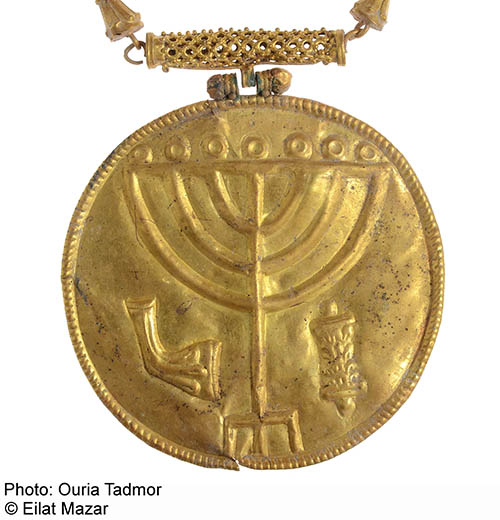 The prize find of the so-called Ophel treasure unearthed in the Ophel excavations is a gold medallion featuring a menorah, shofar (ram’s horn) and a Torah scroll. Photo: Courtesy of Dr. Eilat Mazar; photo by Ouria Tadmor.
The prize find of the so-called Ophel treasure unearthed in the Ophel excavations is a gold medallion featuring a menorah, shofar (ram’s horn) and a Torah scroll. Photo: Courtesy of Dr. Eilat Mazar; photo by Ouria Tadmor.
The renewed excavation of the Ophel, the area between the City of David and the Temple Mount, occurred between 2009 and 2013. Under the direction of third-generation Israeli archaeologist Eilat Mazar, the excavation unearthed another extraordinary find: the so-called Ophel treasure, a cache of gold coins, gold and silver jewelry and a gold medallion featuring a menorah, shofar (ram’s horn) and a Torah scroll.

